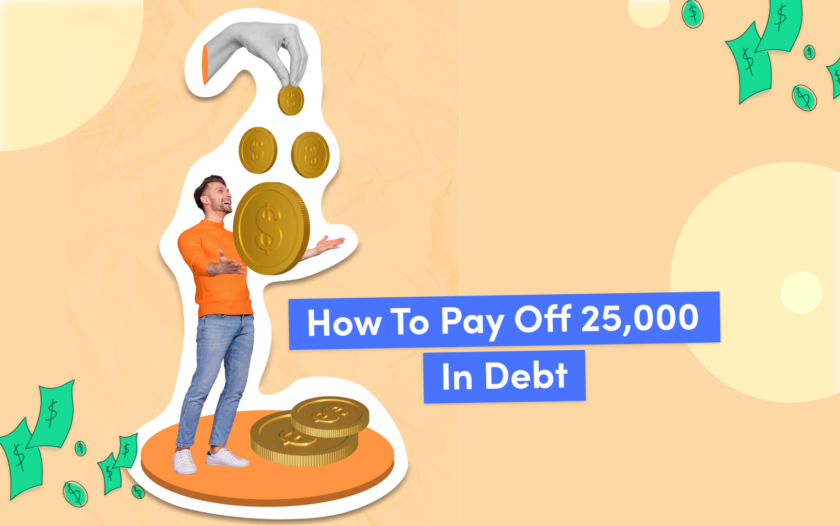Have $25k in Debt? See How To Pay It Off
About Caitlyn
Caitlyn is a freelance writer from the Cincinnati area with clients ranging from digital marketing agencies, insurance/finance companies, and healthcare organizations to travel and technology blogs. She loves reading, traveling, and camping—and hanging with her dogs Coco and Hamilton.
Read full bio
At a Glance
If you find yourself facing a $25,000 debt mountain, you’re not alone. The good news is that there are various strategies and methods to help you navigate through this financial challenge and emerge debt-free. In this guide, we’ll explore different ways to pay off a $25,000 debt, additional tips to accelerate your debt payoff, and information on seeking assistance.
In this article, you’ll learn:
Ways to pay off $25,000 in debt
1. Debt consolidation loan
Debt consolidation can be a viable option if you have multiple debts with varying interest rates. A debt consolidation loan:
- Allows you to combine your debts into a single loan with a fixed interest rate, making it easier to budget and predict when you’ll have the debt paid off.
- It can simplify your monthly payments and potentially lower your overall interest payments.
- May help you pay off your debts faster.
Find and compare the best debt consolidation loan options.
Use the filters below to refine your search

Sorry, we didn’t find any options that meet your requirements. Please try modifying your preferences.
Congratulations! You’re close to seeing your offers!
Please take a second to review the details you shared earlier
Sorry, we didn’t find any options that meet your requirements. Please try modifying your preferences.
2. Debt snowball method
The debt snowball method is a debt repayment strategy popularized by financial expert Dave Ramsey. It involves paying off your smallest debts first, regardless of interest rates, until that debt is completely paid off. Then, you move on to your next smallest, and so on until you pay everything off. (Don’t forget to make the minimum payments on all of your debts to avoid fees and damage to your credit score). This method can provide psychological wins early on, helping to build momentum in your debt payoff journey.
Learn More: Debt Snowball Method to Pay Off Debt
3. Debt avalanche method
Alternatively, the debt avalanche method prioritizes paying off debts with the highest interest rates first. Once that’s repaid, you move on to your next highest, and so on. As with the debt snowball method, you’ll also continue making minimum payments on other debts. However, this approach can save you money on interest payments over time and is particularly effective for those focused on minimizing long-term costs.
Learn More: Everything You Need to Know About the Debt Avalanche Method
4. Check for balance transfer credit card options
Consider exploring balance transfer credit card options as a way to consolidate high-interest credit card debt. These cards often offer a promotional period with low or 0% APR, allowing you to make significant progress on your debt without accruing additional interest charges. Just make sure you pay down the balance before the intro APR period is over or you’ll accrue interest at a much higher rate, and be aware of balance transfer fees and limits.
Learn More: How Does a Credit Card Balance Transfer Work?
Additional tips for paying off debt
1. Reduce interest rates
- Credit cards: Contact your credit card companies to negotiate lower interest rates. A lower interest rate means more of your payment goes toward reducing the principal balance, accelerating your debt payoff.
- Student loans: Explore options for refinancing or consolidating student loans to secure a lower interest rate. If you have private student loans you can also try negotiating lower rates with your lender. This can result in substantial long-term savings.
- Personal loan: Taking out a personal loan to consolidate your debt and pay it down can lead to huge savings, especially if the personal loan rate is lower than your other outstanding debts.
Read More: How to Get a Personal Loan - Auto loans: If you have an auto loan, check if refinancing is an option. Lowering your interest rate can free up funds for debt repayment. However, keep in mind that refinancing to a new loan could extend your repayment period, which means you’ll be in debt longer. Ask your lender if they charge a prepayment penalty for eliminating the debt balance before the end of the loan term.
2. Reduce credit card debt
- Minimize credit card usage: Put a temporary halt on using credit cards to prevent adding to your debt. Focus on cash or debit card transactions to control your spending and avoid increasing the balance that’s accruing interest.
- Pay your due amount every month: Make it a priority to pay at least the minimum amount due on your credit cards every month. This helps maintain a positive credit history and avoids additional fees. However, the more you can pay, the better. Your goal should be to pay off your credit card balance in full each month.
3. Look for additional income sources
Explore opportunities to increase your income, such as a part-time job, freelance work, or selling items you no longer need. Allocating extra funds to debt repayment can expedite the payoff process.
4. Minimize your spending
Evaluate your budget and identify areas where you can cut expenses. This could include entertainment, dining out, shopping, subscriptions or memberships you don’t need, and more. Sacrifices may be necessary in the short term to achieve your long-term goal of becoming debt-free.
How to get additional help with debt?
Sometimes when you’re drowning in debt, coming up with a plan to pay it off can seem overwhelming. If this happens, consider contacting a credit counselor. Credit counselors can provide debt management advice and help in negotiating down your debts. While it’s not guaranteed, they may be able to lower your total balance or your interest rate (called a debt management plan), making it easier to pay off your debt.
Besides no guarantee, other downsides include damage to your credit score and potential fees.
Additionally, there are financial assistance programs out there at both the national, state, and local levels to help people who are facing financial difficulties due to their debt.
A financial advisor may also be able to help you create a debt repayment plan and a financial plan once your debts are paid off to help you reach your goals.
FAQs
Achieving such a rapid debt payoff requires a combination of aggressive budgeting, additional income sources, and potentially using consolidation methods. While it may not be feasible for everyone, those willing to make significant sacrifices and commit to a focused strategy can increase their chances of success. Consider:
- Creating a budget.
- Increasing your income.
- Prioritizing high-interest debts.
- Negotiating lower balances or interest rates.
- Cutting non-essential spending.
- Exploring balance transfer options.
- Seeking professional advice.
The time it takes to pay off $25,000 in credit card debt depends on various factors, including your financial situation, monthly budget, and the strategy you choose. However, using online calculators or consulting with a financial professional can help you estimate the time required based on your unique circumstances.
Paying off $30,000 in debt in one year is a challenging but achievable goal with careful planning, discipline, and commitment. Following these steps:
- Review all of your debts, monthly income, and essential expenses.
- Create a detailed budget of both essential and non-essential spending and identify areas where you can cut costs.
- Set a realistic timeline and be realistic about the sacrifices you may need to make.
- Prioritize high-interest debts.
- Increase your income.
- Negotiate lower interest rates and possibly debt settlement.
- Consider a balance transfer.
- Utilize windfalls and any additional income.
- Stay motivated.
- Seek professional guidance.
Paying off credit card debt when you have limited financial resources can be challenging, but it’s not impossible. Create a detailed budget to see where your money is going and prioritize your basic expenses while allocating everything else to debt. Try to negotiate with creditors to lower your interest rate or extend payment terms. You may also want to consider debt consolidation options. Increase your income with another job or by selling things you no longer need. You may also consider contacting a credit counseling agency or exploring other debt-relief options.









